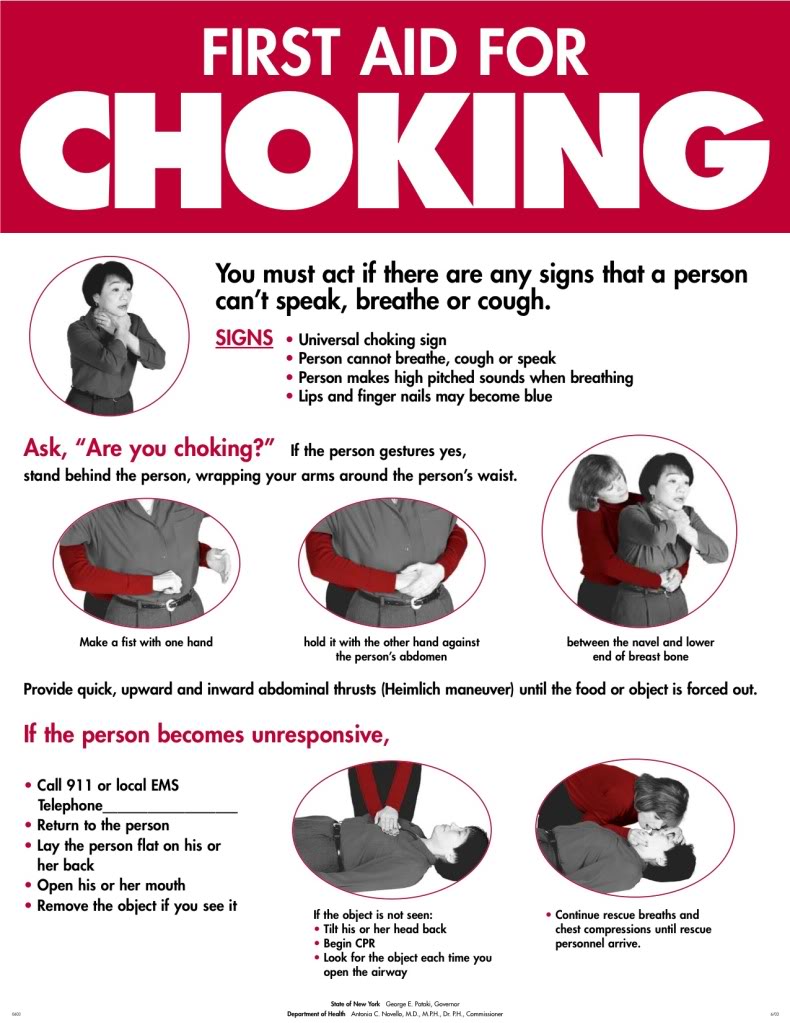Choking First aid
مجلة الجودة الصحية- إعداد: ود خالد
Choking occurs when a foreign object becomes lodged in the throat or windpipe, blocking the flow of air. In adults, a piece of food often is the culprit. Young children often swallow small objects. Because choking cuts off oxygen to the brain, administer first aid as quickly as possible.
The universal sign for choking is hands clutched to the throat. If the person doesn’t give the signal, look for these indications:
Inability to talk
Difficulty breathing or noisy breathing
Inability to cough forcefully
Skin, lips and nails turning blue or dusky
Loss of consciousness
:If choking is occurring, the Red Cross recommends a “five-and-five” approach to delivering first aid
Give 5 back blows.First, deliver five back blows between the person’s shoulder blades with the heel of your hand.
Give 5 abdominal thrusts.Perform five abdominal thrusts (also known as the Heimlich maneuver).
Alternate between 5 blows and 5 thrustsuntil the blockage is dislodged.
The American Heart Association doesn’t teach the back blow technique, only the abdominal thrust procedures. It’s OK not to use back blows, if you haven’t learned the technique. Both approaches are acceptable.
:To perform abdominal thrusts (Heimlich maneuver) on someone else
Stand behind the person.Wrap your arms around the waist. Tip the person forward slightly.
Make a fist with one hand.Position it slightly above the person’s navel.
Grasp the fist with the other hand.Press hard into the abdomen with a quick, upward thrust — as if trying to lift the person up.
Perform a total of 5 abdominal thrusts,if needed. If the blockage still isn’t dislodged, repeat the five-and-five cycle.
If you’re the only rescuer, perform back blows and abdominal thrusts before calling 911 or your local emergency number for help. If another person is available, have that person call for help while you perform first aid.
If the person becomes unconscious, perform standard CPR with chest compressions and rescue breaths.
:To perform abdominal thrusts (Heimlich maneuver) on yourself
First, if you’re alone and choking, call 911 or your local emergency number immediately. Then, although you’ll be unable to effectively deliver back blows to yourself, you can still perform abdominal thrusts to dislodge the item.
Place a fistslightly above your navel.
Grasp your fistwith the other hand and bend over a hard surface — a countertop or chair will do.
Shove your fistinward and upward.
:To clear the airway of a pregnant woman or obese person
Position your hands a little bit higherthan with a normal Heimlich maneuver, at the base of the breastbone, just above the joining of the lowest ribs.
Proceed as with the Heimlich maneuver,pressing hard into the chest, with a quick thrust.
Repeatuntil the food or other blockage is dislodged or the person becomes unconscious.
:To clear the airway of an unconscious person
Lower the personon his or her back onto the floor.
Clear the airway.If a blockage is visible at the back of the throat or high in the throat, reach a finger into the mouth and sweep out the cause of the blockage. Be careful not to push the food or object deeper into the airway, which can happen easily in young children.
Begin cardiopulmonary resuscitation (CPR)if the object remains lodged and the person doesn’t respond after you take the above measures. The chest compressions used in CPR may dislodge the object. Remember to recheck the mouth periodically.
:To clear the airway of a choking infant younger than age 1
Assume a seated position and hold the infant facedownon your forearm, which is resting on your thigh.
Thump the infant gently but firmlyfive times on the middle of the back using the heel of your hand. The combination of gravity and the back blows should release the blocking object.
Hold the infant faceup on your forearmwith the head lower than the trunk if the above doesn’t work. Using two fingers placed at the center of the infant’s breastbone, give five quick chest compressions.
Repeat the back blows and chest thrustsif breathing doesn’t resume. Call for emergency medical help.
Begin infant CPRif one of these techniques opens the airway but the infant doesn’t resume breathing.
If the child is older than age 1, give abdominal thrusts only.
To prepare yourself for these situations, learn the Heimlich maneuver and CPR in a certified first-aid training course.







